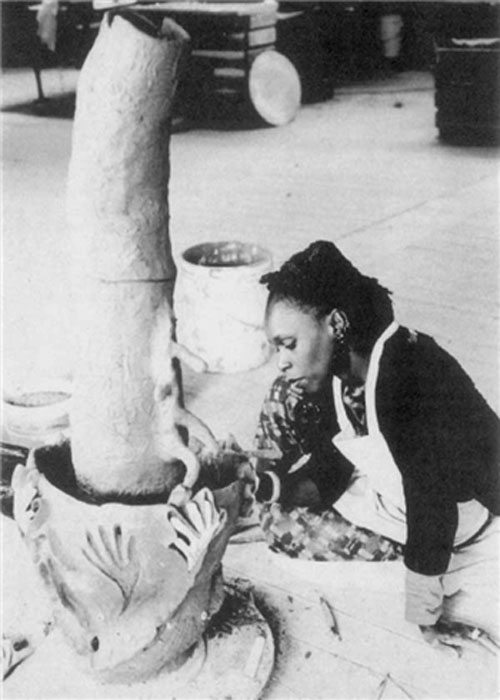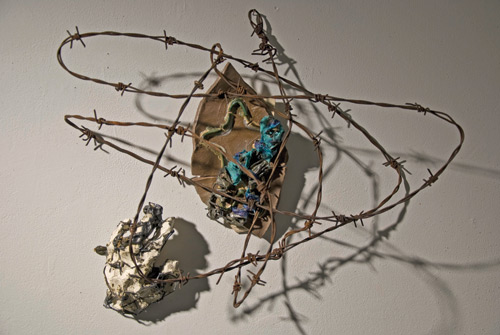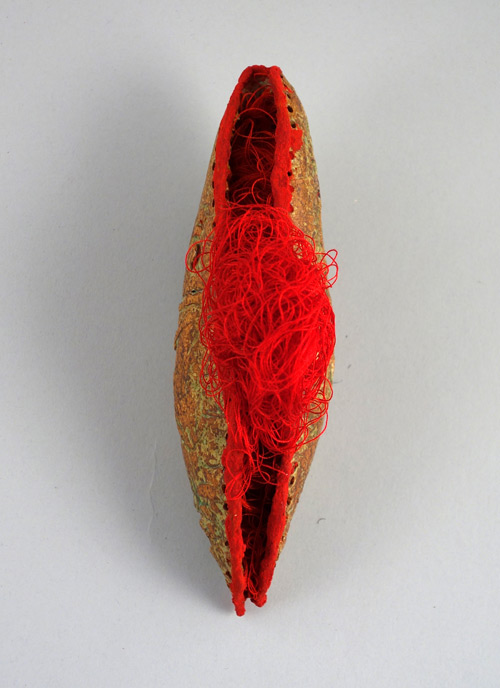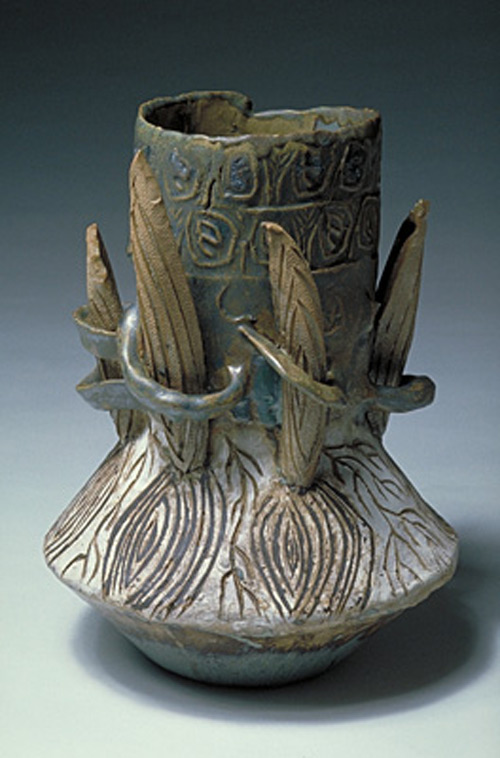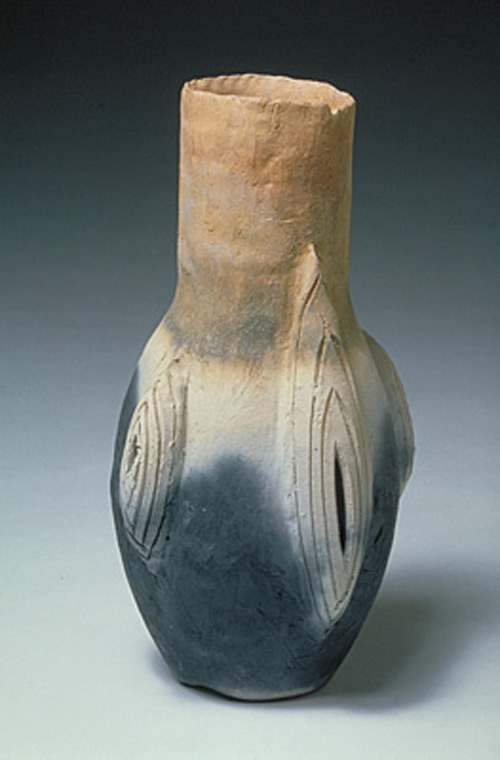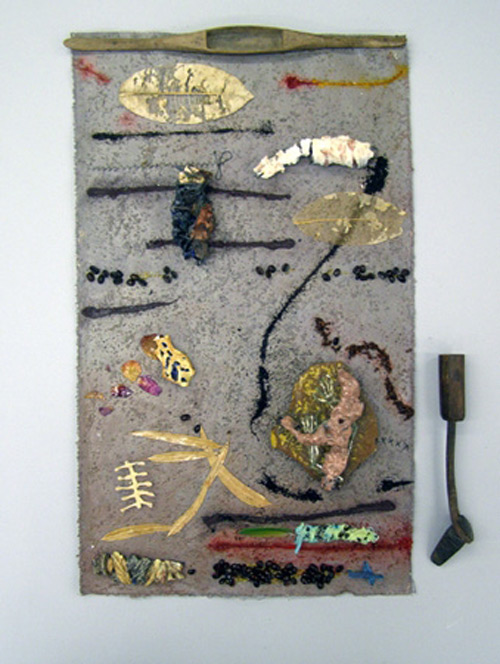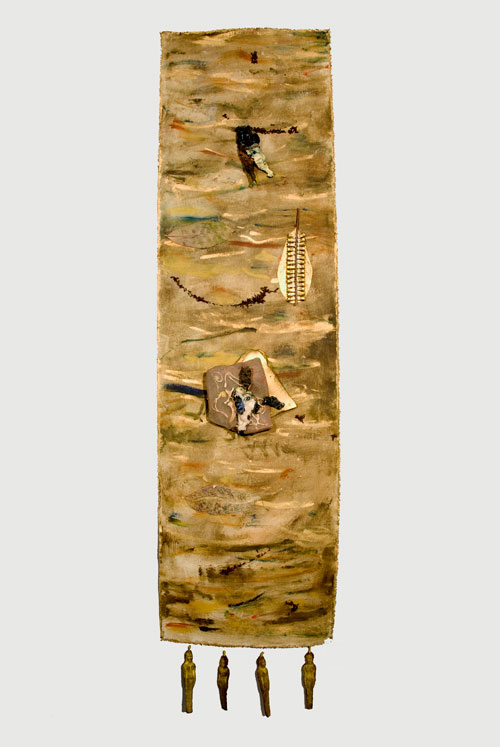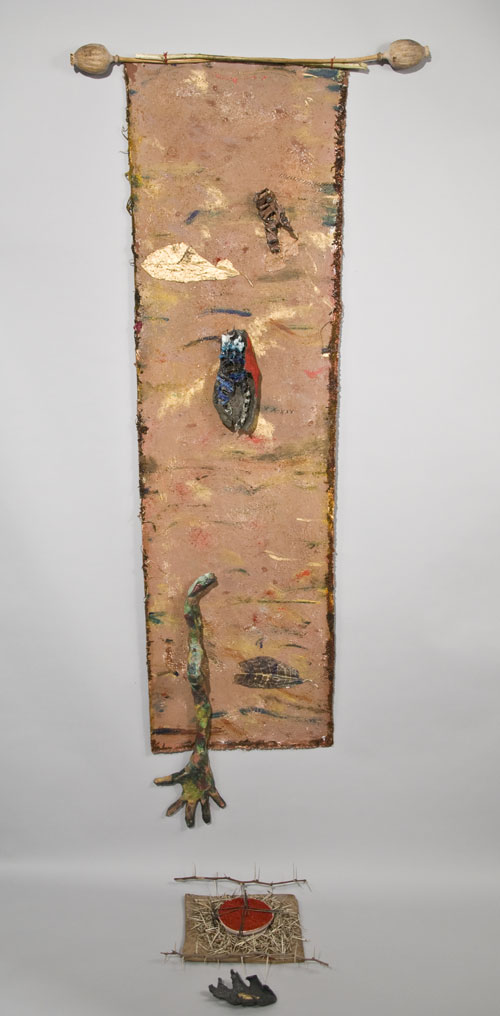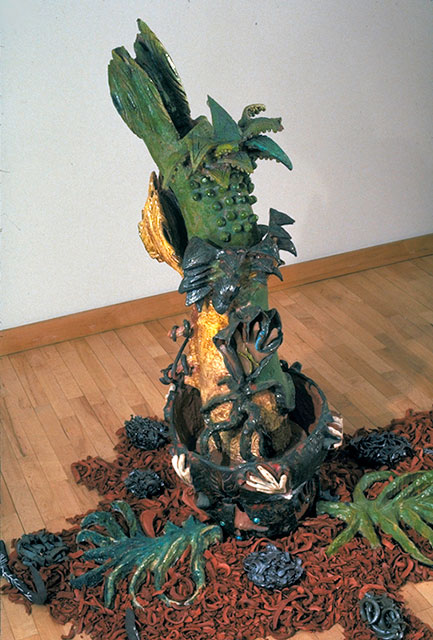

By CINDI DI MARZO
Body & Soul features 24 artists responding with clay to the pain of living in an exploitative, violent world. The emotionally charged pieces gathered for this show argue for the impact that socially committed artists can have on individual lives, and Musasama is just such an artist. Given the extent of the world’s problems and the millions of people suffering because of them, Musasama is also a model for 21st-century artists who want to be relevant to contemporary issues as well as earn a place in art history.
June Kelly of the June Kelly Gallery in New York, which represents her, commented: “Musasama has long had a political edge to her artwork and that is one reason I am attracted to it. The power of her work arises from her forms and selection of iconic elements, and from the sense of reverence she achieves, making unforgettable our individual associations with the nameless and the voiceless. Sana’s voice is worldwide. The art world seems to be catching up.”
Inspired by dire social issues, abusive situations and harsh living conditions, Musasama’s sculptures are imbued with a deep understanding and compassion, achieved through day-to-day living with the afflicted. Where age-old prejudice and tradition might seem intransigent, she opens a window to change; where abuse leads to wounds of soul and spirit, she offers the possibility of inner freedom; and where complex problems threaten to overwhelm, she provides light through insight.
Yet Musasama’s means of confronting crisis directly by her physical presence trumps even her transcendent sculptures. Her career proves that one artist willing to go the extra miles – literally – can change lives for the better, while creating objects of beauty. Her sculptures are strong yet delicate, symbolically rich yet straightforward, intriguing yet accessible. But take note: her get-out-there-and-do-it approach may prick a few consciences.
A native of New York City, Musasama is also a bona fide global citizen. Her father served in the Navy, so in childhood she became accustomed to moving from one home to another. When Musasama was a young adult, an aunt took her on continental journeys, thus planting a seed that grew into this dedicated traveller. Now, her medium and social concerns guide her steps; Musasama follows where clay and her heart lead.
After receiving her bachelor’s degree from the City University of New York, Musasama continued her studies at Mende Pottery in Sierra Leone, West Africa, Tuscarora Pottery School in Nevada, and in Japan. Returning to New York in the 80s, she completed a Master of Fine Arts at New York State College of Ceramics at Alfred University. In 1992, she began the Outer Beauty/Inner Anguish series, based on her observations of female culture in Mendeland, particularly genital cutting of adolescents. In 1995, Musasama started her Unspeakable series to explore the practice. It is a subject that remains vital to her consciousness, as she has heard about younger girls being cut.
Her Unknown/Unnamed series developed from trips she has made to Cambodia for the past six years to work with girls rescued from sex-trafficking by human rights activist Somaly Mam. Musasama first read about Mam, a former sex slave, in Glamour magazine’s coverage of its 2006 Women of the Year awards. Moved to take an active role in these girls’ lives, Musasama brought dolls made by her students at the Centre for Alternative Sentencing and Employment Services in New York to Mam’s safe houses and gave materials to the girls for their own doll-making projects. In these workshops, girls contribute different elements to a doll, thereby forming a relationship with each other as unique creators. Subsequently, Mam met Musasama in New York and recognised her as the “pocketbook” lady, much spoken of by girls who learned to make pocketbooks and other crafts from the artist.
The large sculptures in Musasama’s Maple Tree series reference the Maple Tree abolitionist movement of the 1790s, when Native Americans, free indentured servants and Dutch colonists in New York protested against the use of slaves to harvest sugar cane in the West Indies. The group embraced the Maple tree because its sweet sap can be collected without a large workforce.
With her frequent globetrotting, one may wonder how Musasama finds time to make art. After Body & Soul opened in September, she turned her attention to a solo exhibition at Kean University in Union, New Jersey, and a group show at Kingsborough Community College in Brooklyn,1 meanwhile teaching as an adjunct associate professor at Hunter College, John Jay College of Criminal Justice, New Jersey Community College and Jamaica Centre for Arts & Learning. She speaks and writes about the connection between the arts and society, and contributed a chapter to a book focusing on the subject, Voices of Color: Art and Society in the Americas.2
As Musasama prepared for her show at Kean University and launched her new website (http://sana-musasama.com), she talked to Studio International about the origins of her fascination with clay, her roles as artist, activist and teacher, and her plans for the future.
Cindi Di Marzo: Thank you for speaking with Studio International, Sana. I want to start at the birth of your passion for ceramics. When and how did you begin sculpting with clay?
Sana Musasama: I played around with clay as a child and was reintroduced to clay at City College [of the City University of New York] in the early 70s. I loved the smell of the studio. I loved that women populated the classroom. I loved the stories I heard there. I loved the forms that were shaped with such care. I went to the professor and asked if he would sign me into the class. He agreed and I ended up finding myself in the clay.
CDM: You have said that you choose travel destinations based on the types of clay in a particular locale and the history of an area’s clay-making practices. Is this what drew you to Sierra Leone?
SM: I was thirsty for learning, but did not find the classroom to be my way of learning. I had completed my undergraduate work at City College and still felt uneducated. I promised myself that I would not sit in a classroom again. I had never travelled by myself before, yet I heard powerful stories in the ceramic studio from my peers who were fortunate enough to travel during semester breaks. While my buddies were away, I worked to pay for my tuition and to allow me to join them on their trips. While I worked and waited, I went to the library and discovered that clay exists all over the world. It comes in a great variety of colours and personalities, just as we human beings do.
When I was ready to travel, in 1975, I went to Ghana. I chose West Africa because I am a black American and I wanted my ancestral home to be my foundation. At the airport I met a man named La hai, a Sierra Leonean who took me to his home village. I lived there for several seasons. I did not know the language well enough to communicate. I learned by observation, in a very deep way. I imitated the women and little girls who were my guides. Our sisterhood began with the little girls combing my hair, trying on my clothes, showing me how to cook on three stones, how to wash my body and clothes in the river. They taught me how to sit like a Mendeland woman, to eat like a Mendeland woman, and to sing and dance like a Mendeland woman. Most of all, they taught me how to be safe in their culture. I love these sassy woman-like little girls and I cherish the time I spent with them.
I went to the farms daily and helped with the families’ labours. We fished together, weaved together, ate together, made pottery together, repaired our clay huts and clay ovens together. I sat on the clay earth and sorted coco beads with them. We smiled and laughed in good times. We cried when a life was lost. I began to accept and trust life in a fundamental way, even when it challenged my sensibilities.
Africa is a magical place. Being there strengthened my womanhood and redirected my aesthetics. The experience propelled me to be a better person; to become a contributing member of the human family; to have empathy and compassion; and to ask questions rather than judge. I arrived empty in Africa and returned home full.
CDM: You began working on Outer Beauty/Inner Anguish and the Unspeakable series many years after your first trip to Sierra Leone. At the time you lived among the young women there, you did not know about female circumcision. Did being involved in their lives and participating in some of their less secretive rituals affect your views?
SM: Everything about their lives impacted mine: the way the seasons guide their activities, the gender limitations and rewards of being a woman in their society, the separation of women and men, how the women adorned themselves and their beautiful hairstyles, their pottery forms and textiles, the foods they prepared, their bonds of sisterhood, their love of their children, their watchful eyes on their daughters. Their daily labours were non-stop.
I was unaware of the ritual of female circumcision at the time, but in 1991 it became a heavily covered topic in the news. I read each article with keen interest and understood that I had been in the midst of a 7,000-year-old tradition. I was an outsider in their culture, although I rarely felt like one. No one spoke to me about this practice, but I noticed that the girls acted differently – and differently towards me – after some secret rite had occurred in their lives. So I returned to Africa to learn more.
CDM: After you read about Somaly Mam, you travelled to Cambodia to teach the young women she shelters. How has making crafts become a cathartic, healing force in their lives?
SM: To create is to give birth to something new. We are rebuilding ourselves as we construct new forms. As artists, we use care, love and our intellect to shape formless materials into objects of beauty and purpose. The common denominator is love, and in the process we are transformed and, thus, healed.
CDM: You have reached a high level of craftsmanship. How have different techniques and philosophies influenced you?
SM: In Africa and Japan, the notion of craftsmanship is not discussed. You look at a form, handle it, put it to your mouth. You use it. You witness others using it. You make close associations with your own body and you create. In the United States, we are taught to consider these associations but only when we are making functional forms. I consider these physical concepts in everything I do – cooking, making art, decorating my home and my studio, adorning myself.
CDM: Your plate is quite full with travelling and teaching. How do you juggle these roles with art-making?
SM: Sometimes I feel that I have little choice, but this is the life that I chose. I teach five classes, have commitments in my creative life, exhibitions, lectures, workshops, and must make time for looking at art and getting out into the world. I am a sister, an auntie and great auntie, a good friend and neighbour to many, a mentor, a colleague. I am not an artist who is in the studio daily. I wish I could be and hope that, one day, I will have only studio time.
When I do carve out time to create, nothing else exists for many months. I keep detailed journals of everything I see that touches me. I record the time of year, the time of day, the colour of the sky, smells, sounds, emotions. I have been writing journals since I was about 13. I grew up in a crowded household with my mom and dad, four sisters and my aunt Dot, who lived with us at the weekends. Neighbours and relatives visited regularly. Our Sunday dining room table was fertile ground for me, surrounded by my father’s buddies from the Navy and friends from diverse places all over the world. I recorded it all.
CDM: Can you give Studio International’s readers a glimpse of upcoming trips and exhibitions?
SM: I leave for Cambodia at Christmastime. This will be my seventh year working with the girls there. I consider them to be my girls now. When I return from Cambodia, I begin applying for grants, residencies and lectures for the coming years.
In January 2014, I will exhibit at the Hood Museum of Art at Dartmouth College in New Hampshire and will be a visiting artist there in April. In May, I go to Paris, where Gallerie 43 opens a show of my work in June. From Paris, I make my first trip to Morocco. I want to visit the markets and spend time with the women selling their pottery. In summer 2015, I will be an artist-in-residence at Cité Internationale des Arts in Paris, revisiting a position I held 17 years ago.
CDM: Clearly, the road is calling you again, Sana. We wish you the best as you continue to express painful social problems in your sculptures and help to alleviate them in your workshops.
References
1. Sana Musasama: Conversations at the Nancy Dryfoos Gallery, Kean University, runs until 16 January 2014: http://www.kean.edu/~gallery/Nancy-Dryfoos-Gallery.html; Reawakening: A Celebration in Clay of Nature and Renewal at Kingsborough Community College runs to 29 November 2013: http://sana-musasama.com/events/category/exhibition/upcoming/
2. Voices of Color: Art and Society in the Americas edited by Phoebe Farris-Dufrene, published by Humanity Books, 2007.
